
Jug, Yorkshire, England, ca. 1830. Stoneware. H. 20". (Noël Hume Collection; photos, Gavin Ashworth, unless otherwise noted.) The exterior of this massive jug is coated with a lustrous red-brown glaze and decorated with multiple sprigs that include portrait busts of William IV (r. 1830–1837) and Queen Adelaide. The interior is coated with an olive-green lead glaze.
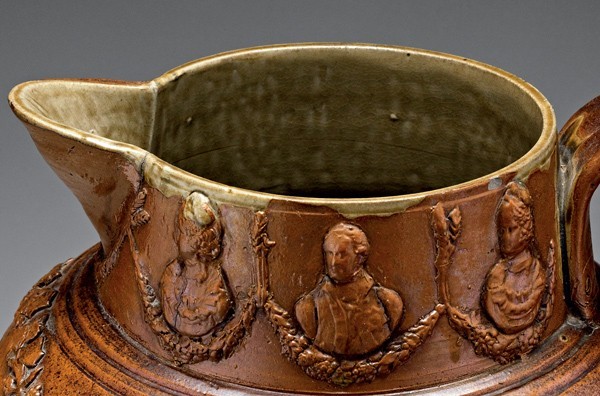
Detail of the jug illustrated in fig. 1: portraits of William IV and Queen Adelaide.

Detail of the jug illustrated in fig. 1: the Stag Kill (W. 5"). The motif is paralleled on a pitcher attributed to Brampton in Derbyshire.

Detail of the jug illustrated in fig. 1: the sloppily applied Hanoverian royal arms and their smug but not too bright flanking lions. Note that the separately sprigged device below the arms has been applied off center.

Detail of the jug illustrated in fig. 1: the dolphin-spearing cherub (H. 4") and, to its right, the erasing and trimming away of another part of the mold’s design.

Detail of the jug illustrated in fig. 1: an unidentified “classical” sprig (W. 4 1/4"), which, having been applied too dry, cracked in firing.
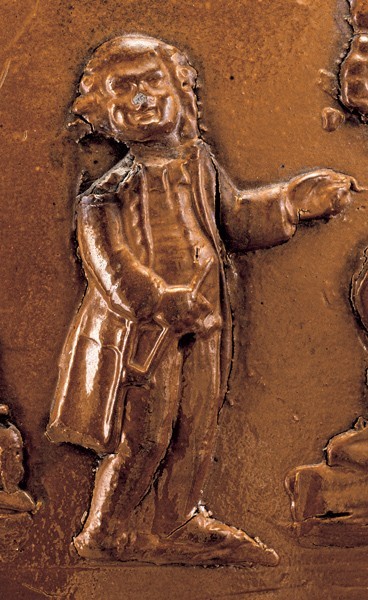
Detail of the jug illustrated in fig. 1: the Parson, with his pipe but without his friends (H. 3 1/8").
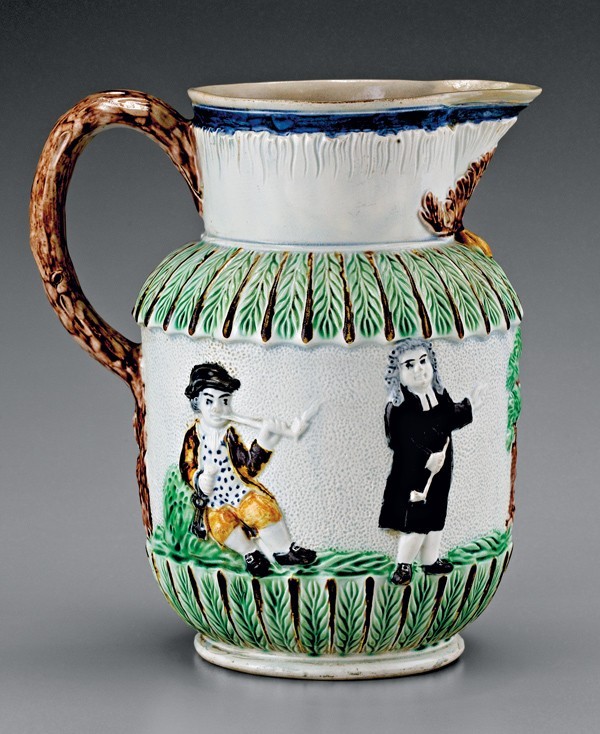
Jug, Staffordshire, ca. 1790–1805. Pearlware. H. 8 1/4". (Noël Hume Collection.) This press-molded pearlware jug shows the Parson and the Sexton.

Detail of the jug illustrated in fig. 1: a hunter scene (W. 5 1/4"), in which a man or boy, surrounded by hunting dogs, shows a hare or rabbit to his companion.

Jug, probably Staffordshire, ca. 1810. Pearlware. H. 6". (Noël Hume Collection.) The hunter scene depicted on this press-molded pearlware jug is decorated in “Pratt” colors. The object in the foreground (unidentifiable on the jug illustrated in fig. 1) might be a dead goose.

Mug, probably Staffordshire, ca. 1825. Yellow ware. H. 5 3/4". (Noël Hume Collection.) The sprigging on this double hound-handled mug was done with particular care. At left is the hunter scene; at right, shooters at rest with their bag and their dog. Both scenes as stoneware sprigs are present on the giant Eccleshill jug illustrated in fig. 15.
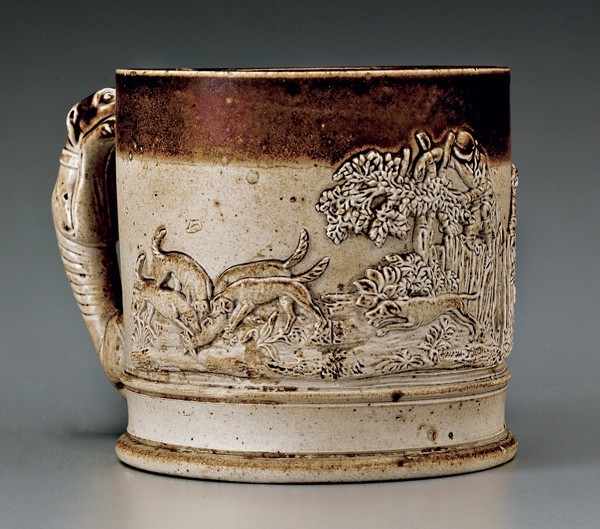
Mug, Derbyshire, ca. 1835. H. 5 1/4". (Noël Hume Collection.) The Fox Kill on this hound-handled mug is the first of a four-sprig frieze.

Detail of the jug illustrated in fig. 1: the dismounted horsemen (W. of each 3 3/4") flanking the Stag Kill scene.

Pitcher, probably Brampton, ca. 1835–1840. Stoneware. H. 15 5/8". (Courtesy, Nicholas Johnson Collection.) The Stag Kill and dismounted huntsmen sprigs on this brown stoneware pitcher parallel those on the jug illustrated in fig. 1. Note the faux screws on both handle and spout.

Jug, attributed to Eccleshill, ca. 1840–1845. H. 24". (Courtesy, Keighley Museum.) A lustrous brown exterior salt glaze and interior olive-green lead glaze cover this giant, which is decorated with portraits of Queen Victoria and Prince Albert as well as the royal arms and hunting scenes. The handle has faux screws at the top and bottom.

Shop jar, Yorkshire, ca. 1840–1850. H. 11 1/2". Pitcher, probably Derbyshire, ca. 1835–1845. H. 5 1/4”. (Noël Hume Collection.) The shop jar, at left, has a pebbled dark brown glaze and is decorated with the Hanoverian royal arms, lions, and topers similar to those on the giant Eccleshill jug illustrated in fig. 15. The pint pitcher, at right, has a lustrous brown upper dip over a drab, unglazed lower body, its sprigs characterized by incised outlining. It has similar albeit larger topers, including the Sexton, who also appears in the pearlware jug illustrated in fig. 8.
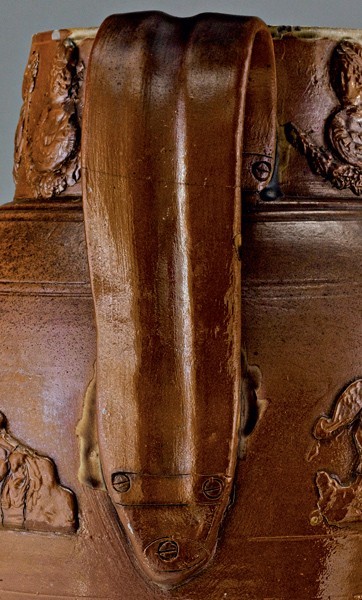
Detail of the jug illustrated in fig. 1, showing the handle with its faux screws and lightly scored lateral straps.
